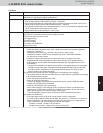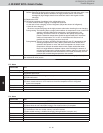
5
5 - 23
W-2WAY ECO-i SYSTEM
Trouble Diagnosis
4. W-2WAY ECO-i Alarm Codes
P03, P17 Alarm
Alarm code P03, P17
Alarm meaning Compressor 1 discharge temperature trouble; Compressor 2 discharge temperature trouble
Alarm conditions Temperature is 222°F or higher and pre-trip stop has occurred.
The alarm occurs when pre-trip stop occurs more than once. However the pre-trip counter is
cleared if the compressor operates continuously for a specified length of time.
Probable cause (1) Clogging of liquid valve capillaries
(2) Insufficient amount of refrigerant (including trouble resulting from an insufficient initial charge
and from gas leakage)
(3) Blocking of low-pressure parts caused by intrusion of foreign objects (moisture, scale, etc.)
(4) Crossing (tubing or PCB connectors) with the other compressor thermistor
(5) Expansion valve operation failure
(6) Accumulation of refrigerant at stopped outdoor units
(7) Compressor discharge sensor failure
(8) PCB failure (A/D conversion failure)
(9) Electrical noise
Check (1) Clogging of capillaries
Trouble: Compressor discharge temperature does not decrease even when the liquid valve
is ON.
Check: When the liquid valve is operating and the liquid valve is ON, check that the
secondary side of the liquid capillaries is cold.
(2) Insufficient refrigerant
Trouble: Liquid effectiveness is poor.
Check: Check whether or not the superheating temperature is declining if the evaporator
mechanical valve is opened to 300 pulses or more (after checking for foreign object
intrusion).
(3) Foreign object intrusion
Trouble: Liquid valve effectiveness is poor.
Check: Check that there is no difference in the condensation or frost conditions between
the strainer primary-side and secondary-side tubing.
(4) Crossed thermistor
Trouble: The discharge temperature of the other compressor is high although only this
compressor is operating.
When the liquid valve turns ON, the discharge temperature of the other compressor
decreases.
(5) Accumulation of refrigerant in stopped outdoor units
Trouble: • System is OK when all outdoor units are operating, however symptoms of
insufficient gas occur when a certain outdoor unit is stopped.
• Condensation or frost is visible up to the top of the accumulator of the stopped
outdoor unit.
• After an outdoor unit stops, there is the sound of refrigerant flowing into an outdoor
unit that was stopped for a long time.
• When an outdoor unit starts after being stopped for a long time, the start is
accompanied by much vibration.
Check: • Representative parts include the liquid capillaries (secondary side of capillaries will
be cool during cooling operation), mechanical valve, mechanical valve bypass check
valve (sound of refrigerant flow can be heard, and stops when the liquid valve is
closed), hot gas defrost valve (if valve secondary side remains hot even after much
time has passed, be careful not to mistake transmitted heat for a valve failure).
• Ice is growing on the lower parts of some outdoor unit heat exchangers but not on
others.
Because this trouble may occur even in outdoor units with a high operating rate
under conditions of insufficient gas, caution is needed.
(6) Sensor failure
Check: • This alarm is likely to occur when wiring is partially cut. (It is difficult to identify, even
when continuity is checked.) The detected discharge temperature is high.
• Although such conditions rarely occur, a P02 alarm is likely if the detected discharge
temperature is low.
• Replace the sensor with another discharge sensor and compare the temperature
conditions.
(7) If the cause is still unknown after checking the above, then it is possible that electrical noise
is the cause of the trouble.
Correction (1) Replace the sensor.
(2) Replace the outdoor unit PCB.
(3) Correct the problem locations.
Example All of the probable causes
Notes Operates continuously for a set length of time.
Indicates 2.5 minutes or longer for an inverter unit and 30 seconds or longer for a constant-
speed compressor.


















